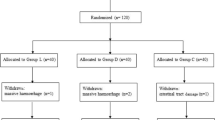Abstract
Purpose
We aimed to evaluate the effect of the intraoperative dexmedetomidine (DEX) on the incidence and severity of catheter-related bladder discomfort (CRBD) after non-urologic surgery. The secondary aim was to find the correlation between the levels of CRBD and postoperative pain sensation.
Methods
Adult male patients undergoing lumbar microdiscectomy were enrolled. Patients were randomized into two groups. After propofol administration, group D (n = 35) received DEX at a loading dose of 1 μg/kg over 10 min, followed by a continuous infusion of 0.3–0.5 μg/kg/h until the end of surgery. In group C (n = 35), an identical volume of 0.9% saline was infused in the same manner. Induction and maintenance of anesthesia were standardized. The incidence and severity of CRBD, postoperative pain, and adverse effects were assessed at 1, 3, and 6 h after surgery.
Results
The incidence of CRBD was significantly lower in group D than in group C at 1 h (34.3 vs. 62.9%, P = 0.017), 3 h (25.7 vs. 60%, P = 0.004), and 6 h (17.1 vs. 54.3%. P = 0.001) postoperatively. The severity of CRBD at 1, 3, and 6 h postoperatively was less in group D than in group C. Postoperative pain score was significantly lower in group D than in group C at 3 and 6 h postoperatively. Adverse events were comparable between two groups. There was a significant correlation between the severity of CRBD and postoperative pain score.
Conclusions
Intraoperative administration of DEX is a safe and effective practice for the prevention of CRBD after lumbar microdiscectomy and can reduce postoperative pain.


Similar content being viewed by others
References
Bai Y, Wang X, Li X, Pu C, Yuan H, Tang Y, Li J, Wei Q, Han P. Management of catheter-related bladder discomfort in patients who underwent elective surgery. J Endourol. 2015;29:640–9.
Agarwal A, Raza M, Singhak V, Dhiraaj S, Kapoor R, Srivastava A, Gupta D, Singh PK, Pandey CK, Singh U. The efficacy of tolterodine for prevention of catheter-related bladder discomfort: a prospective, randomized, placebo-controlled, double-blind study. Anesth Analg. 2005;101:1065–7.
Tauzin-Fin P, Stecken L, Sztark F. Catheter-related bladder discomfort in post-anaesthesia care unit. Ann Fr Anesth Reanim. 2012;31:605–8.
Madhuvrata P, Singh M, Hasafa Z, Abdel-Fattah M. Anticholinergic drugs for adult neurogenic detrusor overactivity: a systematic review and meta-analysis. Eur Urol. 2012;62:816–30.
Buser N, Ivic S, Kessler TM, Kessels AGH, Bachmann LM. Efficacy and adverse events of antimuscarinics for treating overactive bladder: network meta-analyses. Eur Urol. 2012;62:1040–60.
Takizuka A, Minami K, Uezono Y, Horishita T, Yokoyama T, Shiraishi M, Sakurai T, Shigematsu A, Ueta Y. Dexmedetomidine inhibits muscarinic type 3 receptors expressed in Xenopus oocytes and muscarine-induced intracellular Ca2+ elevation in cultured rat dorsal root ganglia cells. Naunyn Schmiedebergs Arch Pharmacol. 2007;375:293–301.
Ryu JH, Hwang JW, Lee JW, Seo JH, Park HP, Oh AY, Jeon YT, Do SH. Efficacy of butylscopolamine for the treatment of catheter-related bladder discomfort: a prospective, randomized, placebo-controlled, double-blind study. Br J Anaesth. 2013;111:932–7.
Kim HC, Hong WP, Lim YJ, Park HP. The effect of sevoflurane versus desflurane on postoperative catheter-related bladder discomfort in patients undergoing transurethral excision of a bladder tumour: a randomized controlled trial. Can J Anesth. 2016;63:596–602.
Nietgen GW, Hönemann CW, Chan CK, Kamatchi GL, Durieux ME. Volatile anaesthetics have differential effects on recombinant m1 and m3 muscarinic acetylcholine receptor function. Br J Anaesth. 1998;81:569–77.
Kim JA, Min JH, Lee HS, Jo HR, Je UJ, Paek JH. Effects of glycopyrrolate premedication on preventing postoperative catheter-related bladder discomfort in patients receiving ureteroscopic removal of ureter stone. Korean J Anesthesiol. 2016;69:563–7.
Binhas M, Motamed C, Hawajri N, Yiou R, Marty J. Predictors of catheter-related bladder discomfort in the post-anaesthesia care unit. Ann Fr Anesth Reanim. 2011;30:122–5.
Srivastava VK, Agrawal S, Kadiyala VN, Ahmed M, Sharma S, Kumar R. The efficacy of pregavaline for prevention of catheter-related bladder discomfort: a prospective, randomized, placebo-controlled double-blind study. J Anesth. 2015;29:212–6.
Agarwal A, Dhiraaj S, Singhal V, Kapoor R, Tandon M. Comparison of oxybutynin and tolterodine for prevention of catheter related bladder discomfort: a prospective, randomized, placebo-controlled, double-blind study. Br J Anaesth. 2006;96:377–80.
Agarwal A, Yadav G, Gupta D, Singh PK, Singh U. Evaluation of intra-operative tramadol for prevention of catheter-related bladder discomfort a prospective, randomized, double-blind study. Br J Anaesth. 2008;101:506–10.
Kim HC, Lim SM, Seo H, Park HP. Effect of glycopyrrolate versus atropine coadministered with neostigmine for reversal of rocuronium on postoperative catheter-related bladder discomfort in patients undergoing transurethral resection of bladder tumor: a prospective randomized study. J Anesth. 2015;29:831–5.
Kim HC, Kim E, Jeon YT, Hwnag JW, Lim YJ, Seo JH, Park HP. Postanaesthetic emergence agitation in adult patients after general anaesthesia for urological surgery. J Int Med Res. 2015;43:226–35.
Schnabel A, Meyer-Frießem CH, Reichl SU, Zahn PK, Pogatzki-Zahn EM. Is intraoperative dexmedetomidine a new option for postoperative pain treatment? A meta-analysis of randomized controlled trials. Pain. 2013;154:1140–9.
Le Bot A, Michelet D, Hilly J, Maesani M, Dilly MP, Brasher C, Mantz J, Dahmani S. Efficacy of intraoperative dexmedetomidine compared with placebo for surgery in adults: a meta-analysis of published studies. Minerva Anestesiol. 2015;81:1105–17.
Abdallah FW, Brull R. Facilitatory effects of perineural dexmedetomidine on neuraxial and peripheral nerve block: a systemic review and meta-analysis. Br J Anaesth. 2013;110:915–25.
Hall JE, Uhrich TD, Barney JA, Arain SR, Ebert TJ. Sedative, amnestic, and analgesic properties of small-dose dexmedetomidine infusions. Anesth Anal. 2010;90:699–705.
Author information
Authors and Affiliations
Corresponding author
Ethics declarations
Conflict of interest
The authors declare that they have no conflicts of interest.
About this article
Cite this article
Kwon, Y., Jang, J.S., Hwang, S.M. et al. Intraoperative administration of dexmedetomidine reduced the postoperative catheter-related bladder discomfort and pain in patients undergoing lumbar microdiscectomy. J Anesth 32, 41–47 (2018). https://doi.org/10.1007/s00540-017-2425-0
Received:
Accepted:
Published:
Issue Date:
DOI: https://doi.org/10.1007/s00540-017-2425-0




